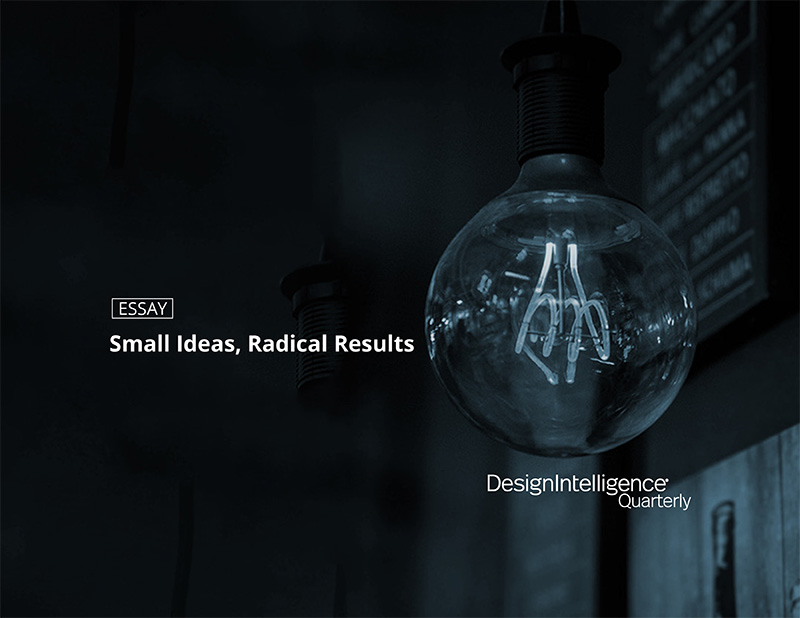Small Ideas, Radical Results
by Scott Simpson
Senior Fellow, Design Futures Council
October 13, 2021
Often Simple Things Matter Most
Unlike kangaroos, human beings don’t have a convenient pouch to carry things around. For thousands of years, we’ve transported our goods using bags, boxes and carts. As technology advanced, we’ve added trains, trucks, ships and airplanes to the repertoire. Now we can send almost anything we want anywhere in the world quickly, conveniently and cheaply. Why, then, did it take thousands of years to create something as simple as a suitcase with wheels? After all, wheels are ancient technology (think chariots) and luggage is just as common, but it wasn’t until 1970 that Bernard D. Sadow invented a rolling suitcase. (He was subsequently awarded U.S. patent no. 3,653,474 for “wheeled luggage” in 1972.) His invention changed the way we travel, and it’s probably fair to say that the market penetration for Mr. Sadow’s simple but brilliant idea approaches 100%. Why did something so obvious and so useful take so long?
It’s easy to overlook simple things, yet it’s the simple things that often have the biggest impact. Consider the lowly gutter, which was first used in the Indus Valley civilization several thousand years ago. The problem with gutters is that they get clogged with dirt and leaves, creating backflow that can result in serious damage to the buildings they are intended to protect. Cleaning gutters can be dirty and dangerous work, yet it wasn’t until 2005 that Matt Kaulig, working out of his basement, came up with the idea for the Leaf Filter Gutter Guard. Simple and ingenious, this system allows gutters to drain better than ever and eliminates the need for cleaning entirely. Problem solved, and it only took 3,000 years.
What does this have to do with the design and construction industry? First, the industry has been around since the dawn of civilization. Second, because people spend much more time inside buildings than they do outdoors, it affects everyone on the planet. Third, it’s both inefficient and a serious source of pollution (data show that 30% of all construction materials wind up as waste and 45% of carbon emissions worldwide are generated by activities related to construction). This makes it an ideal target for innovation: the bar is so low that there’s nothing but upside!

Start with something as basic as getting things on and off a construction site. First, large quantities of soil and rock must be removed, then the process is reversed as new materials are delivered, generally by means of large noisy trucks that cause significant traffic congestion and pollution. Yet we know from using Uber that it’s possible to arrange transportation on demand that will take us to our desired destination by the most efficient route possible while avoiding the need for parking. We can also order our favorite brand of shampoo from Amazon Prime and it will reliably arrive within 24 hours right on our doorstep, often cheaper than we can buy it at the store. Why can’t these same basic principles be applied to construction logistics? Construction deliveries could be scheduled during off hours to avoid clogging traffic and the next day’s materials would be on-site and ready for installation before the workers arrived. Ditto for waste removal. Practical and prudent supply chain management could easily cut on-site waste, perhaps in half, which would save billions of dollars annually. In concept, such an approach is no more difficult that putting wheels on luggage.
Another thought is to eliminate some design and construction altogether. For example, the first space most people encounter in a hospital or clinic is the waiting room. This sends a very strong nonverbal message: “You are now under our control. We expect you to wait for service. We’ll let you know when it’s convenient for us to see you.” Yet there are no waiting rooms in grocery stores, department stores or schools. How come? Technology exists that would enable health care providers to schedule appointments more efficiently and let patients know when the doctor and the exam room are ready. (Some restaurants use pagers for the same reason, and those pagers could easily be replaced by existing cell phones.) Eliminating waiting rooms would not only save space, and hence construction cost, it would also speed up “throughput,” enabling doctors and nurses to serve more patients in a typical day. This would greatly lower operating cost as well. With more efficient operations and faster throughput, the number of exam rooms could be reduced, increasing the overall savings. Add to this the prospect of telemedicine for routine check-ins, and it’s easy to see that “process design” could generate significant savings in health care delivery. A 5% reduction in the $3 trillion of annual medical costs in the U.S. each year comes to $150 billion — not a bad payout for a few simple tweaks.
There are two kinds of innovation: accidental and intentional. In 1968, Spencer Silver was working for the 3M Company on creating a new adhesive. In the process he accidentally stumbled upon a sticky glue that was relatively weak and didn’t leave a residue, which made it reusable. This led to the invention of Post-It Notes. Legend has it that they were first used to mark the pages in Mr. Silver’s church choir book. It took 12 more years before the invention was commercialized. Post-It Notes now come in 27 sizes, 57 colors and even 20 fragrances. Some 50 billion of them are sold each year, all thanks to a happy accident.

Inventions can also result from deliberate intent, even if they take a long time to discover and develop. Charles Goodyear spent many years (and most of his family’s fortune) trying to devise a way to process the sap from South American rubber trees so it would not crack in winter or melt in summer. After a decade of fruitless work and lots of blind alleys, he cooked up a mixture of latex sap and sulfur on a hot stove and got the result he was looking for, which he named “vulcanized rubber.” His invention had many industrial uses and should have made Mr. Goodyear a wealthy man, but he spent most of his money defending the patent in court and died $200,000 in debt. Though he did not found the company, Goodyear Tire & Rubber was named in his honor. When it comes to the process of invention, Edison had it right: it’s 1% inspiration and 99% perspiration.
A quick scan of today’s A/E/C industry reveals plenty of potential for innovation based on simple ideas that already exist. (Legend has it that Henry Ford got the idea for his automobile assembly line from visiting a hog processing plant in Chicago.) Computer-aided design (CAD) has been supplanted by building information modeling (BIM), and ever more sophisticated software exists that enables designers to illustrate their ideas remarkably quickly and accurately, including 4D animations. 3D printers have been around for several years and are now being ramped up from producing desktop models to constructing entire buildings. Robotics are becoming increasingly common on construction sites and in the not-too-distant future could account for the bulk of the work performed in the field. Imagine a squad of “robotic painters” turned loose in the evening and to finish an entire job before daybreak; the robots could mix their own paint, apply it and even clean up after themselves, all without the need for masking tape or stopping for a coffee break. Off-site prefabrication of major building components is increasingly common, which enhances quality and lowers cost. Drones could replace trucks in delivering materials on-site and removing waste. And so forth.
Some of the examples cited above relate to “product design” (inventing different things) while others relate to “process design” (devising different ways of doing familiar things). Both are important. Process design can be especially powerful because it results in changed behaviors that make traditional methods obsolete. Sometimes the most efficient way to get something done is to not do it in the first place. A good example of this is hydroponic farming, which eliminates the problem of maintaining the right soil mix to optimize plant growth by having no soil at all.
At its heart, innovation is about problem-solving. While some of these ideas may seem rooted in science fiction, all of them are quite real and eminently practical. Often all it takes to solve a big problem is a small idea, like putting wheels on luggage or rain screens on gutters. Innovation needn’t be radical — it just needs to be effective. Sometimes simple is best.
Scott Simpson, FAIA, is a senior fellow in the Design Futures Council and a regular contributor to DesignIntelligence.


